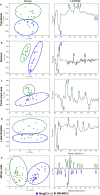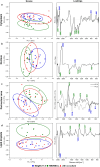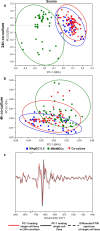Molecular tracking of interactions between progenitor and endothelial cells via Raman and FTIR spectroscopy imaging: a proof of concept of a new analytical strategy for in vitro research
- PMID: 37851174
- PMCID: PMC10584734
- DOI: 10.1007/s00018-023-04986-3
Molecular tracking of interactions between progenitor and endothelial cells via Raman and FTIR spectroscopy imaging: a proof of concept of a new analytical strategy for in vitro research
Erratum in
-
Correction: Molecular tracking of interactions between progenitor and endothelial cells via Raman and FTIR spectroscopy imaging: a proof of concept of a new analytical strategy for in vitro research.Cell Mol Life Sci. 2024 Jan 28;81(1):66. doi: 10.1007/s00018-023-05038-6. Cell Mol Life Sci. 2024. PMID: 38281201 Free PMC article. No abstract available.
Abstract
Circulating endothelial cell progenitors originating from the bone marrow are considered to be a powerful tool in the repair of endothelium damage. Due to their unique properties, endothelial progenitors are now broadly investigated to assess their clinical significance in diseases e.g., associated with brain endothelial dysfunction. However, their distinction in terms of the expression of specific markers remains ambiguous. Additionally, endothelial progenitor cells may change their repertoire of markers depending on the microenvironment of the tissue in which they are currently located. Here, we applied the label-free Raman and FTIR imaging to discriminate mice brain endothelium and endothelial progenitors. Cells cultured separately showed distinctly different spectral signatures extracted from the whole cellular interior as well as the detected intracellular compartments (nucleus, cytoplasm, perinuclear area, and lipid droplets). Then, we used these spectroscopic signals to examine the cells co-cultured for 24Â h. Principal cluster analysis showed their grouping with the progenitor cells and segregation from brain endothelium at a level of the entire cell machinery (in FTIR images) which resulted from biochemical alternations in the cytoplasm and lipid droplets (in Raman images). The models included in partial least square regression indicated that lipid droplets are the key element for the classification of endothelial progenitor-brain endothelial cells interactions.
Keywords: Intercellular interactions; Mouse aorta gonad mesonephros endothelial cells 11.5 (MAgEC11.5); Mouse brain microvascular endothelial cells (MBrMEC); Multivariate analysis; Raman and FTIR imaging.
© 2023. The Author(s).
Conflict of interest statement
The authors have no relevant financial or non-financial interests to disclose.
Figures







References
MeSH terms
Grants and funding
LinkOut - more resources
Full Text Sources

